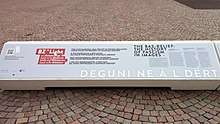Casa del Fascio (Bolzano)
The former Casa del Fascio in Bolzano (also Casa Littoria) was built between 1939 and 1942 in a rationalist style on a project by the architects Guido Pelizzari, Francesco Rossi and Luis Plattner, as the seat of the Italian Fascist Party and its collateral organisations, in Piazza del Tribunale (Gerichtsplatz; formerly Piazza Arnaldo Mussolini). Since the end of World War II it has housed the State Financial Offices and other state bodies operating in South Tyrol.


The convex-shaped building relates to the opposite Justice Palace, built between 1939 and 1956 to a concave design by Paolo Rossi de Paoli and Michele Busiri Vici. The former Casa del Fascio bears a monumental bas-relief designed and sculptured by Hans Piffrader, placed above a large balcony, with Benito Mussolini on horseback in the centre and in the act of the Roman salute and telling the story of the "triumph of Fascism", a work commissioned by the Fascist Party itself. It consists of 57 panels of variable width, 2.75 metres high, placed in two superimposed rows, for a linear development of 36 metres, an area of 198 square metres and a total weight of about 95 tonnes. These dimensions probably make it the most impressive bas-relief made during fascism and still exposed to the public.
Despite being state-owned and continuous protests by German-speaking South Tyroleans, the relief remained untouched for decades. In 2017, like the Bolzano Victory Monument,[1] the Piffrader frieze was also subjected, on the initiative of the South Tyrolean Provincial Administration and on the basis of a joint historical commission proposal[2], to an intervention of historicization and recontextualization, on an artistic project by Arnold Holzknecht and Michele Bernardi, with the affixing of an illuminated inscription bearing a quotation from the philosopher Hannah Arendt in three languages (Italian, German, Ladin) — "No one has the right to obey" — as opposed to the fascist dogma of Believe, obey, combat (Credere, obbedire, combattere) still present on the bas-relief.
An infopoint has been installed on the square itself, with explanatory texts in four languages, explaining the history of the building, Piffrader's work, the more general urban context and the quotation by Hannah Arendt.
Bibliography
- Obermair, Hannes (2017), "Monuments and the City—an almost inextricable entanglement", in Matthias Fink; et al. (eds.), Multiple Identitäten in einer "glokalen Welt"—Identità multiple in un "mondo glocale"—Multiple identities in a "glocal world", Bozen-Bolzano: Eurac Research, pp. 88–99, ISBN 978-88-98857-35-7
- Obermair, Hannes (2018). "Da Hans a Hannah—il "duce" di Bolzano e la sfida di Arendt". Il Cristallo. Rassegna di varia umanità. 60 (1): 27–32. ISBN 978-88-7223-312-2. ISSN 0011-1449.
- Kraus, Carl; Obermair, Hannes (2019). Mythen der Diktaturen. Kunst in Faschismus und Nationalsozialismus – Miti delle dittature. Arte nel fascismo e nazionalsocialismo. Südtiroler Landesmuseum für Kultur- und Landesgeschichte Schloss Tirol. pp. 201–207. ISBN 978-88-95523-16-3.CS1 maint: ref=harv (link)
References
External links
- Official Website
- (in Italian) Susanna Turco, Così a Bolzano hanno "smantellato" il bassorilievo gigante di Benito Mussolini. L'Espresso, November 6, 2017.
- Carlo Invernizzi-Accetti, A small Italian town can teach the world how to defuse controversial monuments. The Guardian, December 6, 2017.
- Poll, Zoey (2020). "The Counter-Monument. Disempowering a memorial to Fascism". Harper's Magazine (08): 62–63. ISSN 0017-789X. Retrieved 2020-07-21.